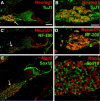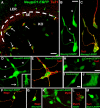Sox2 induces neuronal formation in the developing mammalian cochlea
- PMID: 20071536
- PMCID: PMC2835399
- DOI: 10.1523/JNEUROSCI.3852-09.2010
Sox2 induces neuronal formation in the developing mammalian cochlea
Abstract
In the cochlea, spiral ganglion neurons play a critical role in hearing as they form the relay between mechanosensory hair cells in the inner ear and cochlear nuclei in the brainstem. The proneural basic helix-loop-helix transcription factors Neurogenin1 (Neurog1) and NeuroD1 have been shown to be essential for the development of otocyst-derived inner ear sensory neurons. Here, we show neural competence of nonsensory epithelial cells in the cochlea, as ectopic expression of either Neurog1 or NeuroD1 results in the formation of neuronal cells. Since the high-mobility-group type transcription factor Sox2, which is also known to play a role in neurogenesis, is expressed in otocyst-derived neural precursor cells and later in the spiral ganglion neurons along with Neurog1 and NeuroD1, we used both gain- and loss-of-function experiments to examine the role of Sox2 in spiral ganglion neuron formation. We demonstrate that overexpression of Sox2 results in the production of neurons, suggesting that Sox2 is sufficient for the induction of neuronal fate in nonsensory epithelial cells. Furthermore, spiral ganglion neurons are absent in cochleae from Sox2(Lcc/Lcc) mice, indicating that Sox2 is also required for neuronal formation in the cochlea. Our results indicate that Sox2, along with Neurog1 and NeuroD1, are sufficient to induce a neuronal fate in nonsensory regions of the cochlea. Finally, we demonstrate that nonsensory cells within the cochlea retain neural competence through at least the early postnatal period.
Figures







Similar articles
-
EYA1 and SIX1 drive the neuronal developmental program in cooperation with the SWI/SNF chromatin-remodeling complex and SOX2 in the mammalian inner ear.Development. 2012 Jun;139(11):1965-77. doi: 10.1242/dev.071670. Epub 2012 Apr 18. Development. 2012. PMID: 22513373 Free PMC article.
-
Progression of neurogenesis in the inner ear requires inhibition of Sox2 transcription by neurogenin1 and neurod1.J Neurosci. 2013 Feb 27;33(9):3879-90. doi: 10.1523/JNEUROSCI.4030-12.2013. J Neurosci. 2013. PMID: 23447599 Free PMC article.
-
Dynamic Expression of Sox2, Gata3, and Prox1 during Primary Auditory Neuron Development in the Mammalian Cochlea.PLoS One. 2017 Jan 24;12(1):e0170568. doi: 10.1371/journal.pone.0170568. eCollection 2017. PLoS One. 2017. PMID: 28118374 Free PMC article.
-
Development in the Mammalian Auditory System Depends on Transcription Factors.Int J Mol Sci. 2021 Apr 18;22(8):4189. doi: 10.3390/ijms22084189. Int J Mol Sci. 2021. PMID: 33919542 Free PMC article. Review.
-
The molecular basis of making spiral ganglion neurons and connecting them to hair cells of the organ of Corti.Hear Res. 2011 Aug;278(1-2):21-33. doi: 10.1016/j.heares.2011.03.002. Epub 2011 Mar 21. Hear Res. 2011. PMID: 21414397 Free PMC article. Review.
Cited by
-
The genetics of hair cell development and regeneration.Annu Rev Neurosci. 2013 Jul 8;36:361-81. doi: 10.1146/annurev-neuro-062012-170309. Epub 2013 May 29. Annu Rev Neurosci. 2013. PMID: 23724999 Free PMC article. Review.
-
EYA1 and SIX1 drive the neuronal developmental program in cooperation with the SWI/SNF chromatin-remodeling complex and SOX2 in the mammalian inner ear.Development. 2012 Jun;139(11):1965-77. doi: 10.1242/dev.071670. Epub 2012 Apr 18. Development. 2012. PMID: 22513373 Free PMC article.
-
Expression and function of Sox21 during mouse cochlea development.Neurochem Res. 2011 Jul;36(7):1261-9. doi: 10.1007/s11064-011-0416-3. Epub 2011 Feb 3. Neurochem Res. 2011. PMID: 21287267
-
Directing human induced pluripotent stem cells into a neurosensory lineage for auditory neuron replacement.Biores Open Access. 2014 Aug 1;3(4):162-75. doi: 10.1089/biores.2014.0019. Biores Open Access. 2014. PMID: 25126480 Free PMC article.
-
Evolving gene regulatory networks into cellular networks guiding adaptive behavior: an outline how single cells could have evolved into a centralized neurosensory system.Cell Tissue Res. 2015 Jan;359(1):295-313. doi: 10.1007/s00441-014-2043-1. Epub 2014 Nov 23. Cell Tissue Res. 2015. PMID: 25416504 Free PMC article. Review.
References
-
- Bylund M, Andersson E, Novitch BG, Muhr J. Vertebrate neurogenesis is counteracted by Sox1-3 activity. Nat Neurosci. 2003;6:1162–1168. - PubMed
-
- Chu K, Nemoz-Gaillard E, Tsai MJ. BETA2 and pancreatic islet development. Recent Prog Horm Res. 2001;56:23–46. - PubMed
-
- Collignon J, Sockanathan S, Hacker A, Cohen-Tannoudji M, Norris D, Rastan S, Stevanovic M, Goodfellow PN, Lovell-Badge R. A comparison of the properties of Sox-3 with Sry and two related genes, Sox-1 and Sox-2. Development. 1996;122:509–520. - PubMed
Publication types
MeSH terms
Substances
Grants and funding
LinkOut - more resources
Full Text Sources
Molecular Biology Databases
